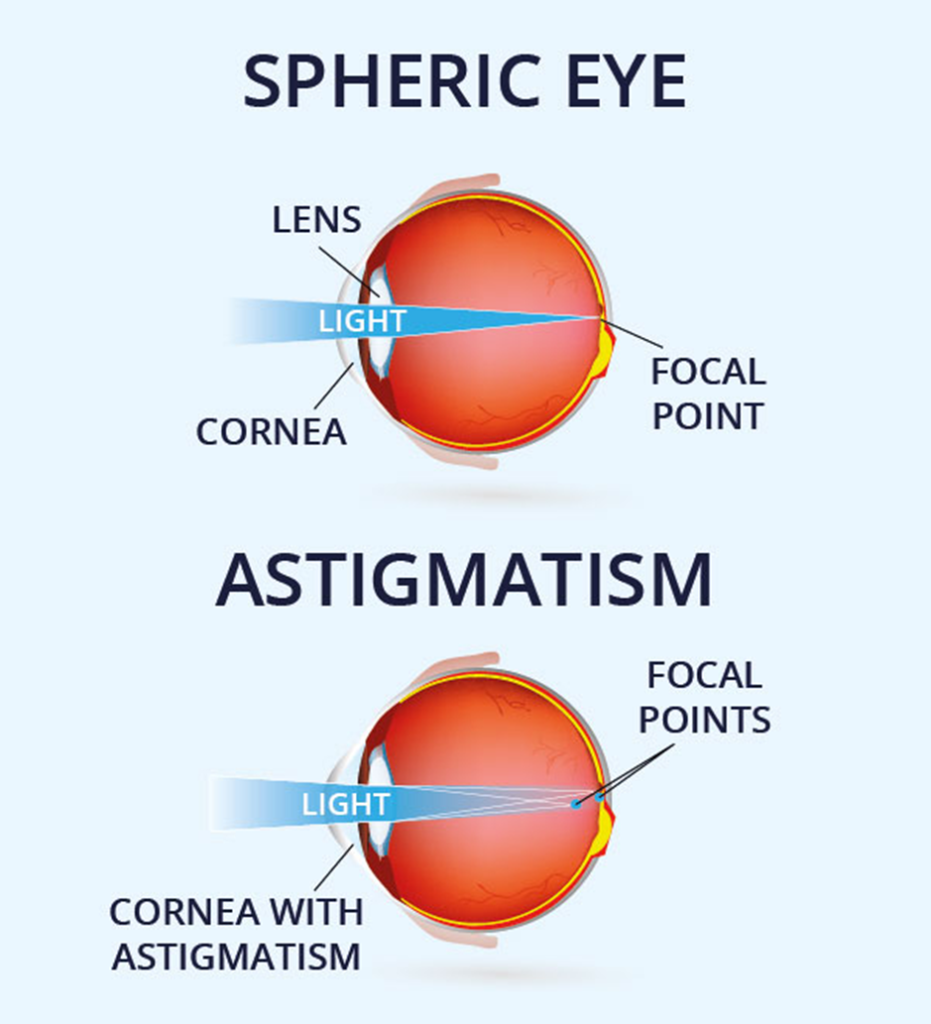Astigmatism is a common refractive error in the eye that occurs when the cornea (the clear front surface of the eye) or the lens inside the eye has an irregular shape. Instead of being evenly curved like a basketball, the cornea or lens is shaped more like a football or an egg. This uneven curvature causes light entering the eye to be focused on multiple points, either in front of or behind the retina, leading to distorted or blurred vision at all distances.
Symptoms of Astigmatism:
- Blurred or distorted vision at both near and far distances.
- Eye strain or discomfort, especially after prolonged tasks like reading or using a computer.
- Difficulty seeing clearly at night.
- Frequent squinting to improve vision.
- Headaches, particularly after tasks requiring focused vision.
Causes of Astigmatism:
- Irregular Corneal Shape: In most cases, astigmatism is caused by an irregularly shaped cornea that has different curvatures in different directions (steeper in one meridian and flatter in another).
- Lens Irregularities: Sometimes, astigmatism can also be caused by irregularities in the shape of the lens inside the eye.
- Genetics: Astigmatism can be inherited, and it’s often present from birth, but it can also develop later in life due to eye surgery, injury, or other conditions.
How Astigmatism Affects Vision:
In an eye without astigmatism, light entering the eye is focused directly onto a single point on the retina, producing clear vision. In astigmatism, because of the uneven curvature of the cornea or lens, light is spread across multiple points, resulting in blurry or distorted images.
Treatment Options:
- Glasses or Contact Lenses: Special toric lenses are used to correct astigmatism. These lenses are shaped in a way that compensates for the uneven curvature of the eye, helping focus light properly on the retina.
- Laser Surgery (LASIK, PRK): These procedures can reshape the cornea to correct the irregular curvature and improve vision by allowing light to focus more accurately on the retina.
- Orthokeratology: Rigid gas-permeable contact lenses are worn overnight to temporarily reshape the cornea and correct vision during the day.
Astigmatism is quite common and can occur along with other refractive errors like myopia (nearsightedness) or hypermetropia (farsightedness). Regular eye exams help diagnose astigmatism early and manage it effectively with corrective lenses or surgery.
Understanding Astigmatism: Causes, Symptoms, and Treatment Options
Astigmatism is a common vision problem that affects millions of people worldwide. It occurs when the cornea or lens inside the eye is irregularly shaped, causing light to focus unevenly on the retina. As a result, individuals with astigmatism experience blurred or distorted vision at all distances, whether they are trying to see objects up close or far away.
What Causes Astigmatism?
Astigmatism is primarily caused by an irregular curvature of the cornea, though it can also be due to abnormalities in the lens. In a healthy eye, the cornea is typically round, like a basketball. However, in people with astigmatism, the cornea is more oblong, similar to a football. This irregular shape prevents light from focusing correctly on the retina, leading to vision issues.
Astigmatism can be hereditary, meaning it is often present from birth, but it can also develop due to eye injuries, surgeries, or conditions like keratoconus. Most cases of astigmatism are mild and can be corrected with glasses or contact lenses.

Symptoms of Astigmatism
If you have astigmatism, you may experience symptoms such as:
- Blurred or distorted vision at any distance
- Eye strain or discomfort after reading or working on a computer
- Headaches, especially after tasks requiring intense focus
- Difficulty seeing clearly at night
- Frequent squinting to improve vision
These symptoms can affect your quality of life, making it essential to get a comprehensive eye exam if you suspect astigmatism.
How to Correct Astigmatism
The good news is that astigmatism is easily treatable. The most common correction methods include:
- Glasses: Prescription glasses with specially designed lenses can help correct the irregular curvature of the cornea, improving your vision.
- Contact Lenses: Toric lenses, which are specially shaped for astigmatism, can help focus light more accurately on the retina.
- Laser Eye Surgery: Procedures like LASIK or PRK can reshape the cornea, correcting the refractive error and eliminating the need for glasses or contacts.
- Orthokeratology: Also known as ortho-k, this treatment involves wearing rigid gas-permeable contact lenses overnight to reshape the cornea temporarily.
Why Regular Eye Exams Are Crucial
Routine eye exams are essential for diagnosing astigmatism early and ensuring you receive the proper treatment. Your eye doctor will evaluate the shape of your cornea and determine the best corrective measures to restore clear vision. Left untreated, astigmatism can worsen over time, making it harder to manage.
If you’re experiencing blurry vision, eye discomfort, or frequent headaches, it’s time to schedule an eye exam to check for astigmatism. Early detection and treatment can help you maintain clear, comfortable vision and prevent further eye strain.